Java--集合框架详解
前言
Java集合框架的知识在Java基础阶段是极其重要的,我平时使用List、Set和Map集合时经常出错,常用方法还记不牢,
于是就编写这篇博客来完整的学习一下Java集合框架的知识,如有遗漏和错误,欢迎大家指出。
以下是我整理的大致Java集合框架内容,本篇博客就是围绕以下内容展开
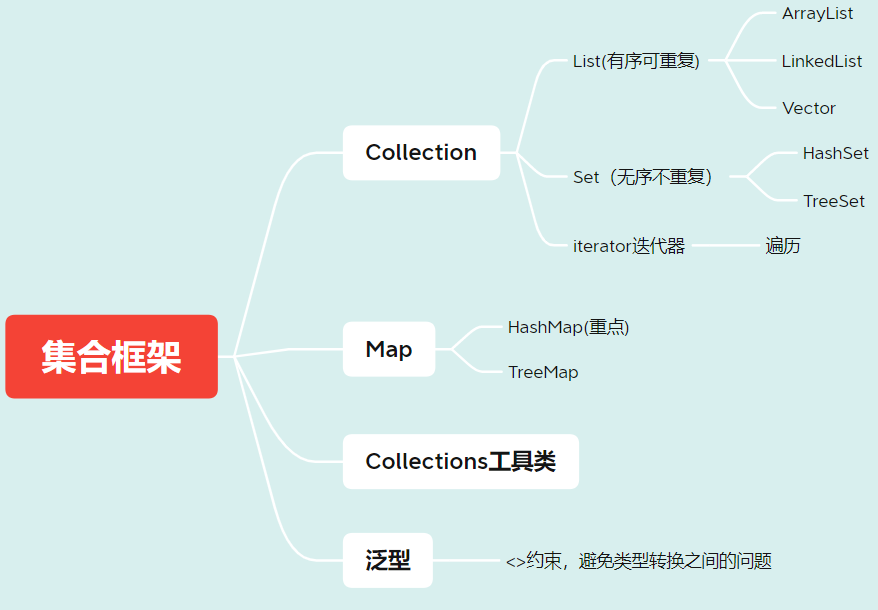
注:本篇博客是根据B站Java集合框架的视频进行编写,视频原地址:【千锋】最新版 Java集合框架详解 通俗易懂
下面我们开始正式学习!!!
1、集合概念
1.1、概念:对象的容器,定义了对多个对象进行操作的常用方法。可实现数组的功能
1.2、集合与数组区别:
数组长度固定,集合长度不固定
数组可以存储基本类型和引用类型,集合只能存储引用类型
1.3、位置:java.util*
2、Collection接口
Collection体系集合
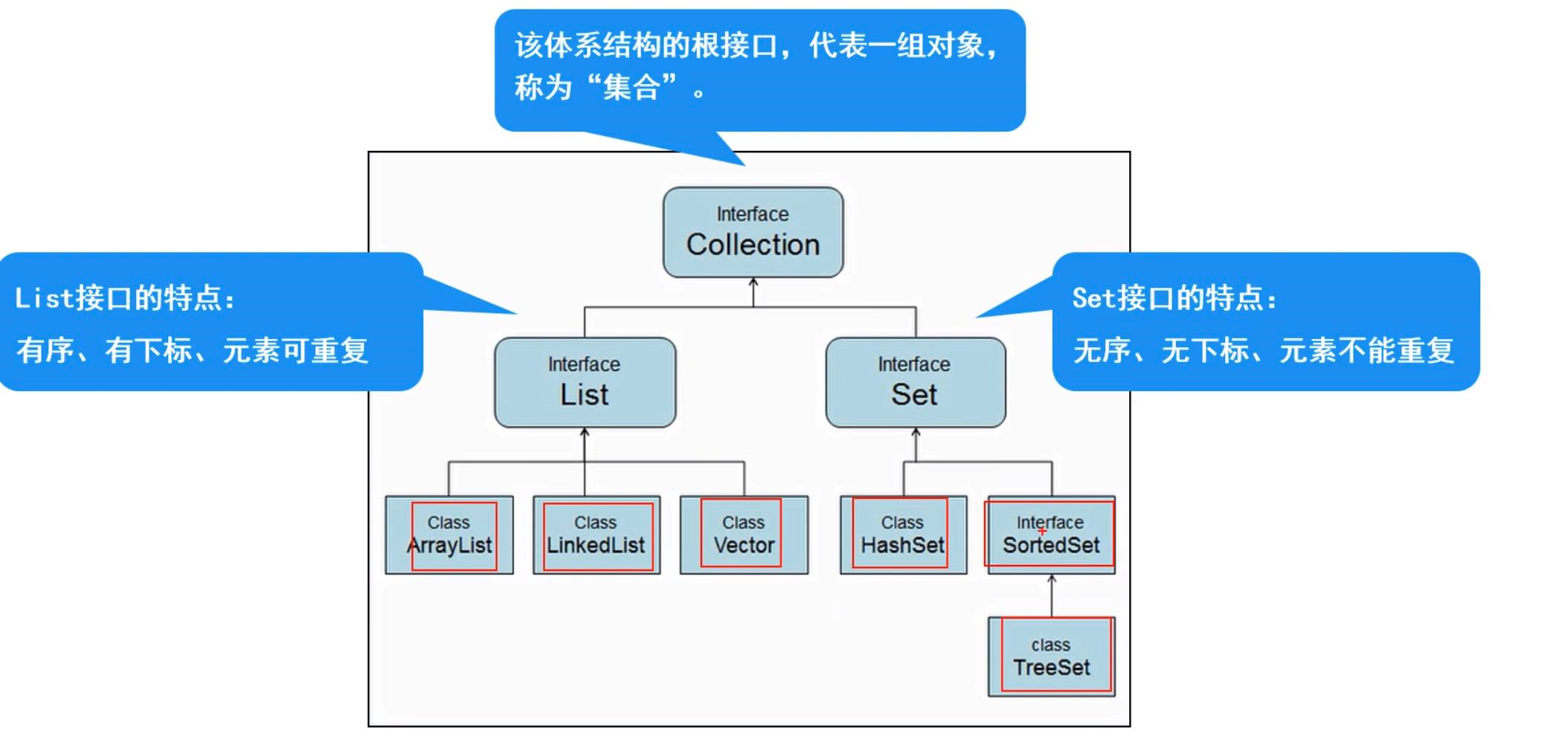
2.1、Collection父接口
特点:代表一组任意类型的对象,无序、无下标、不能重复
方法:
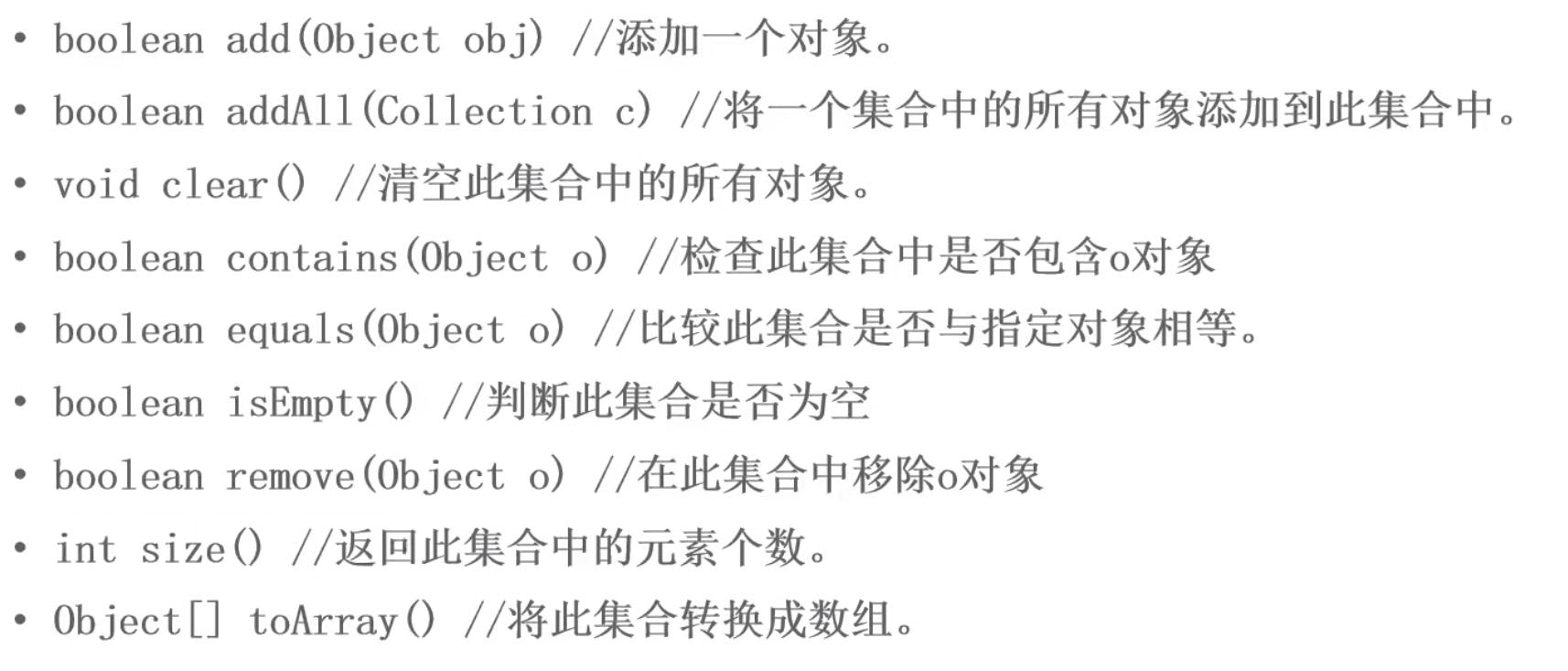
2.2、Collection的使用
(1)Demo1保存字符串(重点关注迭代器iterator的使用)
import java.util.ArrayList;
import java.util.Collection;
import java.util.Iterator;
public class Demo1 {
public static void main(String[] args) {
//创建集合
Collection collection = new ArrayList();
//1.添加元素
collection.add("香蕉");
collection.add("苹果");
collection.add("西瓜");
System.out.println("元素个数:"+collection.size());
System.out.println(collection);
//2.删除元素
//collection.remove("香蕉");
//collection.clear();//清除
//System.out.println("删除之后:"+collection.size());
//3.遍历元素(重点)
System.out.println("==========================");
//方法一:增强for
for (Object object:collection) {
System.out.println(object);
}
//方法二:使用迭代器(迭代器专门用来遍历集合的一种方式)
//iterator3个方法
//hasNext();有没有下一个元素
//next();l获取下一个元素
//remove();删除当前元素
System.out.println("==========================");
Iterator iterator = collection.iterator();
while (iterator.hasNext()) {
String s = (String) iterator.next();
System.out.println(s);
// collection.remove(s);//不允许使用collection删除会引发并发修改错误,只能使用以下方法移除
//iterator.remove();
}
System.out.println("元素个数:"+collection.size());
//4.判断
System.out.println(collection.contains("香蕉"));
System.out.println(collection.isEmpty());
}
}
结果

(2)Demo2 保存学生信息
学生类
//学生类
public class Student {
private String name;
private int age;
public String getName() {
return name;
}
public void setName(String name) {
this.name = name;
}
@Override
public String toString() {
return "Student{" +
"name='" + name + '\'' +
", age=" + age +
'}';
}
public int getAge() {
return age;
}
public void setAge(int age) {
this.age = age;
}
public Student() {
}
public Student(String name, int age) {
this.name = name;
this.age = age;
}
}
import java.util.ArrayList;
import java.util.Collection;
import java.util.Iterator;
// 保存学生信息
public class Demo2 {
public static void main(String[] args) {
//新建Collection对象
Collection collection = new ArrayList();
Student s1 = new Student("张三",18);
Student s2 = new Student("李四",19);
Student s3 = new Student("王五",21);
//1.添加数据
collection.add(s1);
collection.add(s2);
collection.add(s3);
System.out.println("元素个数:"+collection.size());
System.out.println(collection.toString());
//2.删除
//collection.remove(s1);
//System.out.println("删除之后:"+collection.size());
//3.遍历
//方法一:增强for
System.out.println("========增强for===========");
for (Object object:collection) {
Student s = (Student) object;
System.out.println(s.toString());
}
//方法二:使用迭代器(迭代器专门用来遍历集合的一种方式)
System.out.println("========使用迭代器===========");
Iterator iterator = collection.iterator();
while (iterator.hasNext()) {
Student s =(Student) iterator.next();
}
System.out.println(collection.toString());
//4.判断
System.out.println(collection.contains(s1));
System.out.println(collection.isEmpty());
}
}
结果

3、List接口与实现类
3.1、List子接口
特点:有序,有下标,元素可以重复
方法:

3.2、List子接口的使用
(1)Demo3
public class Demo3 {
public static void main(String[] args) {
//先创建一个集合对象
List list = new ArrayList();
//1.添加元素
list.add("唱");
list.add("跳");
list.add(0,"打篮球");//下标为0,放在第一位
System.out.println("元素个数:"+list.size());
System.out.println(list.toString());
//2.删除元素
// list.remove("唱");
// list.remove(1);
// System.out.println("元素个数:"+list.size());
// System.out.println(list.toString());
//3.遍历
//方法一:使用for遍历
System.out.println("===========for遍历===============");
for (int i = 0; i < list.size(); i++) {
System.out.println(list.get(i));
}
//方法二:使用增强for
System.out.println("===========增强for===============");
for (Object o:list) {
System.out.println(o);
}
//方法三:使用迭代器
System.out.println("===========迭代器===============");
Iterator iterator = list.iterator();
while (iterator.hasNext()) {
System.out.println(iterator.next());
}
//方法四:使用列表迭代器
//和迭代器的区别:可以向前或向后遍历,添加、删除、修改元素
System.out.println("===========列表迭代器===============");
ListIterator lit = list.listIterator();
System.out.println("===========列表迭代器从前往后===============");
while (lit.hasNext()) {
System.out.println(lit.nextIndex()+":"+lit.next());
}
System.out.println("===========列表迭代器从后往前===============");
while (lit.hasPrevious()) {
System.out.println(lit.previousIndex()+":"+lit.previous());
}
System.out.println("==========================");
//4.判断
System.out.println(list.contains("rap"));
System.out.println(list.isEmpty());
//5.获取位置
System.out.println(list.indexOf(2));
}
}
结果
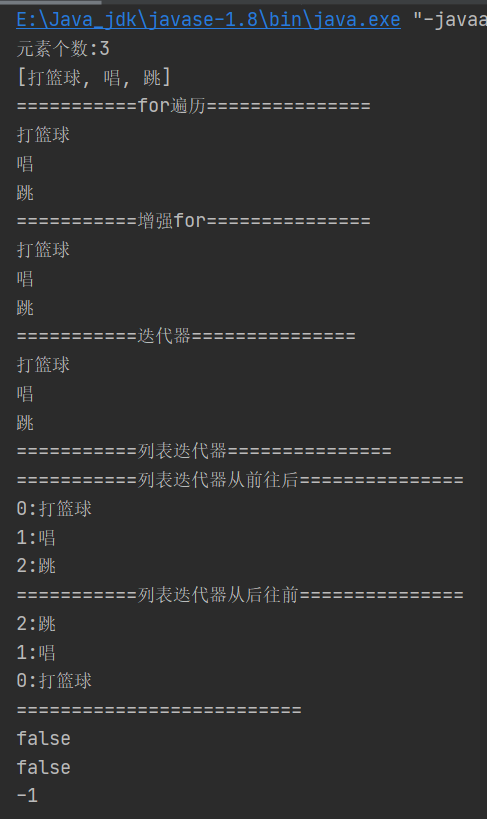
(2)Demo4
public class Demo4 {
public static void main(String[] args) {
//先创建一个集合对象
List list = new ArrayList();
//1.添加数字数据(自动装箱)
list.add(17);
list.add(27);
list.add(37);
list.add(47);
list.add(57);
System.out.println("元素个数:"+list.size());
System.out.println(list.toString());
//2.删除
//注意这里是用脚标删除的,如果要用数字需要转成Object
list.remove(0);
//list.remove((Object) 17);
//list.remove(new Integer(20));
System.out.println("元素个数:"+list.size());
System.out.println(list.toString());
//3.补充方法subList:返回子集合,包含头不包含尾
List subList = list.subList(1, 3);
System.out.println(subList.toString());
}
}
结果:
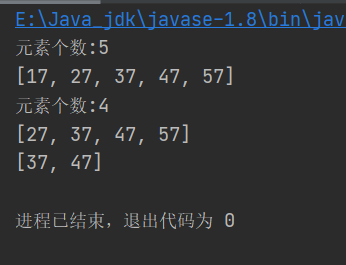
3.3、List实现类
ArrayList(重点):
- 数组结构实现,查询快,增删慢
- jdk1.2版本后加入,运行效率快,线程不安全
Vector:
- 数组结构实现,查询快,增删慢
- jdk1.0版本后加入,运行效率慢,线程安全
LinkedList:
- 链表结构实现,增删快,查询慢
3.3.1、ArrayList
/**
* ArrayList的使用
* 特点:有序,有下标,可以重复
* 存储结构:数组,查找遍历速度快,增删慢
*/
public class Demo5 {
public static void main(String[] args) {
//创建结合
ArrayList arrayList = new ArrayList();
//1.添加元素
Student s1 = new Student("张三",20);
Student s2 = new Student("李四",23);
Student s3 = new Student("王五",19);
arrayList.add(s1);
arrayList.add(s2);
arrayList.add(s3);
System.out.println("元素个数:"+arrayList.size());
System.out.println(arrayList.toString());
//2.删除元素
// arrayList.remove(0);
// arrayList.remove(s2);
arrayList.remove(new Student("ooof",12));//这样删除需要在Student中重写 equals(this == obj) 方法
//3.遍历元素【重点】
//使用迭代器
System.out.println("========= 使用迭代器=========");
Iterator it = arrayList.iterator();
while (it.hasNext()) {
Student s =(Student) it.next();
System.out.println(s.toString());
}
//列表迭代器
System.out.println("========= 列表迭代器=========");
ListIterator lit = arrayList.listIterator();
while (lit.hasNext()) {
Student s =(Student) lit.next();
System.out.println(s.toString());
}
System.out.println("========= 列表迭代器逆序=========");
while (lit.hasPrevious()) {
Student s =(Student) lit.previous();
System.out.println(s.toString());
}
//4.判断
System.out.println(arrayList.contains(new Student("王五",19)));
System.out.println(arrayList.isEmpty());
//5.查找
System.out.println(arrayList.indexOf(new Student("王五",19)));
}
}
结果
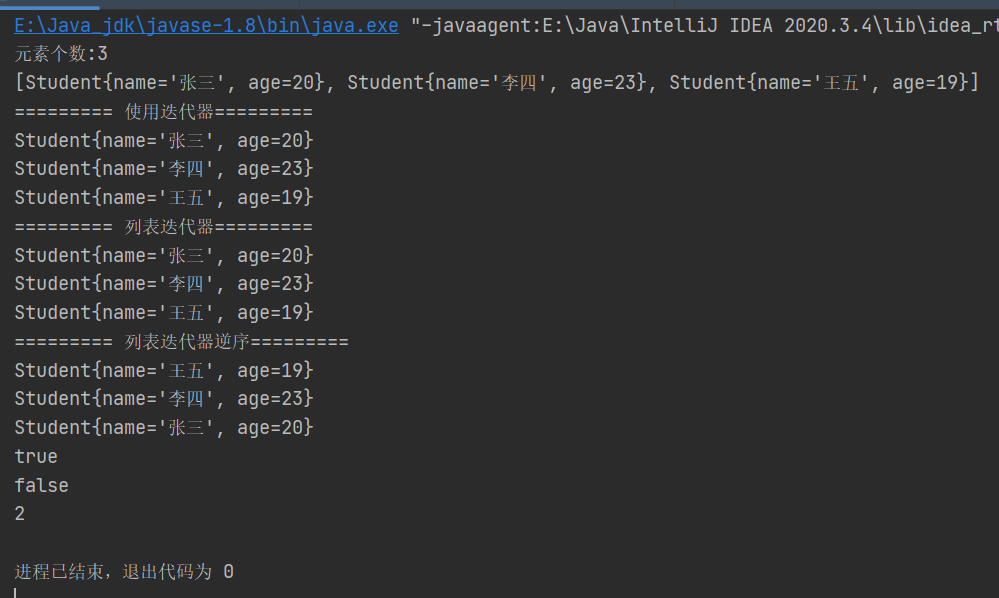
源码分析
默认容量:DEFAULT_CAPACITY = 10;
- 注:如果没有向集合中添加任何元素,容量为0,添加一个元素之后,容量为10,每次扩容大小为原来的1.5 倍
存放元素的数组:elementData
实际元素个数:size
添加元素:add()方法
public boolean add(E e) {
modCount++;
add(e, elementData, size);
return true;
} public void ensureCapacity(int minCapacity) {
if (minCapacity > elementData.length
&& !(elementData == DEFAULTCAPACITY_EMPTY_ELEMENTDATA
&& minCapacity <= DEFAULT_CAPACITY)) {
modCount++;
grow(minCapacity);
}
} //grow为核心
private Object[] grow(int minCapacity) {
int oldCapacity = elementData.length;
if (oldCapacity > 0 || elementData != DEFAULTCAPACITY_EMPTY_ELEMENTDATA) {
int newCapacity = ArraysSupport.newLength(oldCapacity,
minCapacity - oldCapacity, /* minimum growth */
oldCapacity >> 1 /* preferred growth */);
return elementData = Arrays.copyOf(elementData, newCapacity);
} else {
return elementData = new Object[Math.max(DEFAULT_CAPACITY, minCapacity)];
}
}
3.3.2、Vector
存储结构:数组
创建集合
Vector vector = new Vector<>();增加(vector.add())、删除(vector.remove)、判断(vector.contains())同上
遍历--枚举器遍历
Enumeration en = vector.elements();
while(en.hasMoreElements()){
String s = (String)en.nextElement();
sout(s);
}
3.3.3、LinkedList
/**
*LinkedList的使用
* 存储结构:双向链表
* 可以重复添加
*/
public class LinkedListTest1 {
public static void main(String[] args) {
//创建集合
LinkedList linkedList = new LinkedList<>();
//1.添加元素
Student s1 = new Student("张三",20);
Student s2 = new Student("李四",23);
Student s3 = new Student("王五",19);
linkedList.add(s1);
linkedList.add(s2);
linkedList.add(s3);
System.out.println("元素个数:"+linkedList.size());
System.out.println(linkedList.toString());
//2.删除
// linkedList.remove(s1);
// System.out.println("删除之后:"+linkedList.size());
//3.遍历
//for遍历
System.out.println("========for=====");
for (int i = 0; i < linkedList.size(); i++) {
System.out.println(linkedList.get(i));
}
System.out.println("========增强for=====");
for (Object object:linkedList) {
Student s = (Student) object;
System.out.println(s.toString());
}
//迭代器
System.out.println("========迭代器=====");
Iterator it = linkedList.iterator();
while (it.hasNext()) {
Student s =(Student) it.next();
System.out.println(s.toString());
}
System.out.println("========列表迭代器=====");
ListIterator lit = linkedList.listIterator();
while (lit.hasNext()) {
Student s =(Student) lit.next();
System.out.println(s.toString());
}
//4.判断
System.out.println(linkedList.contains(s1));
System.out.println(linkedList.isEmpty());
//5.获取
System.out.println(linkedList.indexOf(s1));
}
}
结果
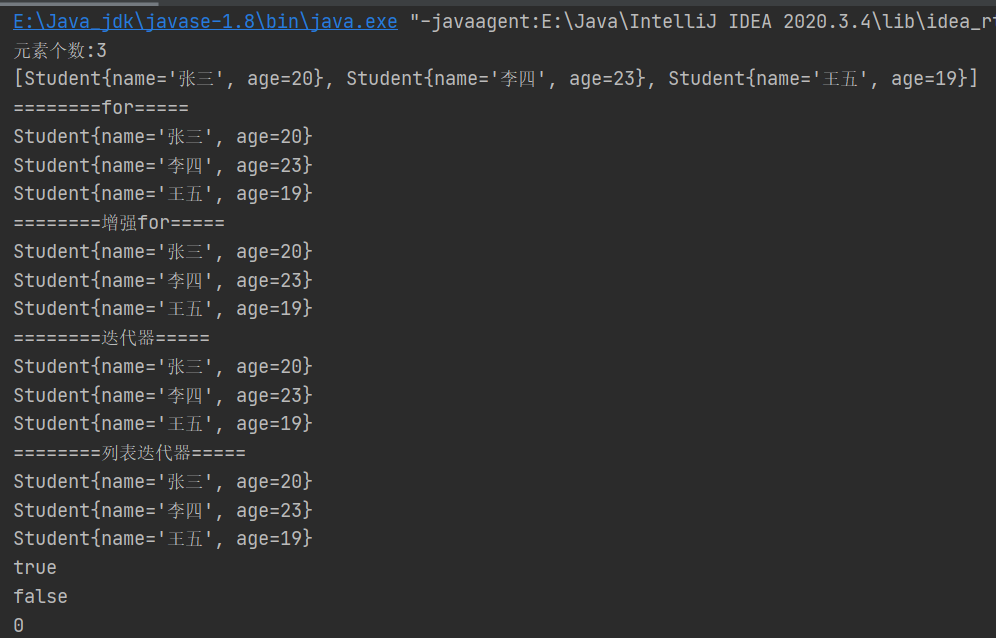
源码分析
transient int size = 0;//集合大小
transient Node<E> first;//头结点
transient Node<E> last;//尾节点
public boolean add(E e) {
linkLast(e);
return true;
}
void linkLast(E e) {
final Node<E> l = last;
final Node<E> newNode = new Node<>(l, e, null);
last = newNode;
if (l == null)
first = newNode;
else
l.next = newNode;
size++;
modCount++;
}
3.4、ArrayList与LinkedList的区别
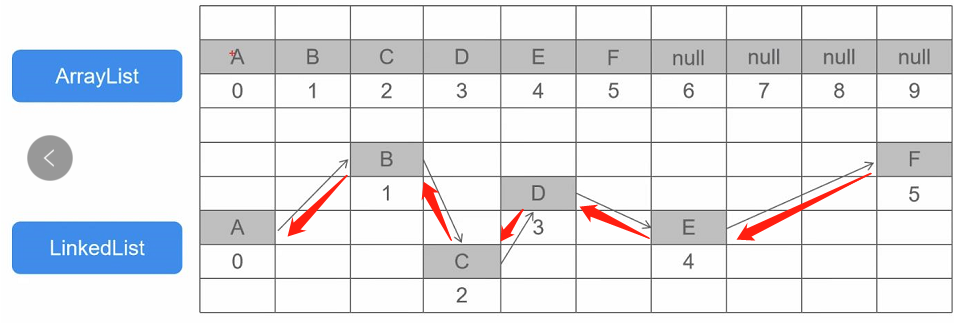
ArrayList:数组,必须开辟连续空间,查询快,增删慢
LinkedList:双向链表,无需开辟连续空间,查询慢,增删快
4、泛型和工具类
泛型
- Java泛型是JDK1.5中引入的一个新特性,其本质是參数化类型,把类型作为参数传递
- 常见形式有泛型类、泛型接口、泛型方法
- 语法:
- <T,...>T称为类型占位符,表示一种引用类型。
- 好处:
- (1)提高代码的重用性
- (2)防止类型转换异常,提高代码的安全性
泛型类
/**
* 泛型类
* 语法:<T>
* T表示类型占位符,表示一种引用类型,如果编写多个用逗号隔开
* */
public class MyGeneric<T> {
//使用泛型T
//1.创建变量,不能new T()因为T数据类型不确定
T t;
//2.创建一个方法,作为方法的参数
public void show(T t){
System.out.println(t);
}
//3.使用泛型作为方法的返回值
public T getT(){
return t;
}
}
public class TestGeneric {
public static void main(String[] args) {
//使用泛型类创建对象
//注意:1.泛型只能使用引用类型,2.不同泛型类型对象之间不能相互赋值
MyGeneric<String> myGeneric = new MyGeneric<String>();
myGeneric.t = "hello";
myGeneric.show("你好");
String t1 = myGeneric.getT();
MyGeneric<Integer> myGeneric2 = new MyGeneric<Integer>();
myGeneric2.t = 100;
myGeneric2.show(200);
Integer t2 = myGeneric2.getT();
}
}
结果:

泛型接口
/**
*泛型接口
* 语法:接口名<T>
* 注意:不能使用泛型来创建静态常量
*/
public interface MyInterface<T> {
String name = "张三";
T server(T t);
}
泛型接口实现有两种方法:
1、指定数据类型
public class MyInterfaceImpl implements MyInterface<String>{
@Override
public String server(String t) {
System.out.println(t);
return t;
}
}
测试
MyInterfaceImpl impl = new MyInterfaceImpl();
impl.server("KKKKKKKK");
2、不指定数据类型
public class MyInterfaceImpl2<T> implements MyInterface<T>{
@Override
public T server(T t) {
System.out.println(t);
return t;
}
测试
MyInterfaceImpl2 impl2 = new MyInterfaceImpl2();
impl2.server(1000);
结果:

泛型方法
/**
*泛型方法
* 语法:<T>返回值类型
*/
public class MyGenericMethod {
//泛型方法
public <T> void show(T t){
System.out.println("泛型方法"+t);
}
}
测试
//泛型方法
//不需要指定类型
MyGenericMethod myGenericMethod = new MyGenericMethod();
myGenericMethod.show("坤坤");
myGenericMethod.show(200);
myGenericMethod.show(3.1415);
结果:

泛型集合
- 概念:参数化类型、类型安全的集合,强制集合元素的类型必须一致。
- 特点:
- 编译时即可检查,而非逐行时抛出异常。
- 访问时,不必类型转换(拆箱)。
- 不同泛型之间引用不能相互赋值,泛型不存在多态。
public class DemoCollect {
public static void main(String[] args) {
ArrayList<String> arrayList = new ArrayList<String>();
arrayList.add("xxx");
arrayList.add("yyy");
//指定String类型一下两条数据就不能添加进去
// arrayList.add(10);
// arrayList.add(20);
for (String str:arrayList) {
System.out.println(str);
}
ArrayList<Student> arrayList2 = new ArrayList<Student>();
Student s1 = new Student("张三",18);
Student s2 = new Student("李四",19);
Student s3 = new Student("王五",21);
arrayList2.add(s1);
arrayList2.add(s2);
arrayList2.add(s3);
Iterator<Student> iterator = arrayList2.iterator();
while (iterator.hasNext()) {
Student s = iterator.next();
System.out.println(s.toString());
}
}
}
测试

5、Set接口与实现类
5.1、Set子接口
特点:无序,无下标,元素不可重复
方法:全部继承自Collecton中的方法
5.2、Set子接口的使用
/**
* 测试Set接口的使用
* 特点:无序,无下标,元素不可重复
*/
public class Demo1 {
public static void main(String[] args) {
//创建集合
HashSet<String> set = new HashSet<>();
//1.添加数据
set.add("唱");
set.add("跳");
set.add("rap");
//set.add("rap");重复添加不进去
System.out.println("数据个数:"+set.size());
System.out.println(set.toString());
//2.删除
set.remove("唱");
System.out.println(set.toString());
//3.遍历【重点】
System.out.println("----增强for----");
for (String str:set) {
System.out.println(str);
}
System.out.println("----迭代器----");
Iterator<String> iterator = set.iterator();
while (iterator.hasNext()) {
String s = iterator.next();
System.out.println(s);
}
//4.判断
System.out.println(set.contains("打篮球"));
System.out.println(set.isEmpty());
}
}
测试:(注意这里添加的顺序与显示的顺序不同,因为无序)
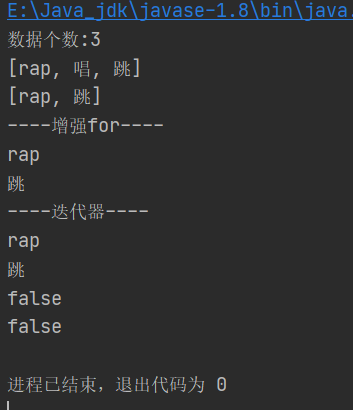
5.3、Set实现类
- HashSet【重点】:
- 基于HashCode实现元素不重复。
- 当存入元素的哈希码相同时,会调用equalsi进行确认,如结果为true,则拒绝后者存入。
- TreeSet:
- 基于排列顺序实现元素不重复。
- 实现了SortedSet接口,对集合元素自动排序
- 元素对象的类型必须实现Comparable接口,指定排序规则
- 通过CompareTo方法确定是否为重复元素
5.3.1、HashSet
HashSet的使用
(1)Demo2
/***
* HashSet集合的使用
* 存储结构:哈希表(数组+链表+红黑树)
*/
public class Demo2 {
public static void main(String[] args) {
//新建集合
HashSet<String> hashSet = new HashSet<>();
//1.添加元素
hashSet.add("张三");
hashSet.add("李四");
hashSet.add("王五");
hashSet.add("赵六");
System.out.println("数据个数:"+hashSet.size());
System.out.println(hashSet.toString());
//2.删除
hashSet.remove("张三");
System.out.println("删除后数据个数:"+hashSet.size());
System.out.println(hashSet.toString());
//3.遍历
System.out.println("----增强for----");
for (String str:hashSet) {
System.out.println(str);
}
System.out.println("----迭代器----");
Iterator<String> iterator = hashSet.iterator();
while (iterator.hasNext()) {
String s = iterator.next();
System.out.println(s);
}
//4.判断
System.out.println(hashSet.contains("打篮球"));
System.out.println(hashSet.isEmpty());
}
}
测试
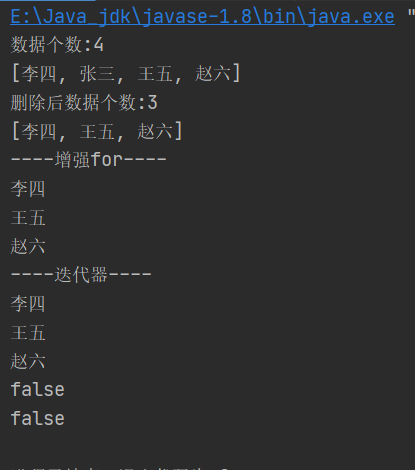
(2)Demo3
person类
public class Person {
private String name;
private int age;
@Override
public String toString() {
return "Person{" +
"name='" + name + '\'' +
", age=" + age +
'}';
}
public String getName() {
return name;
}
public void setName(String name) {
this.name = name;
}
public int getAge() {
return age;
}
public void setAge(int age) {
this.age = age;
}
public Person() {
}
public Person(String name, int age) {
this.name = name;
this.age = age;
}
@Override
public int hashCode() {
int n1 = this.name.hashCode();
int n2 = this.age;
return n1+n2;
}
@Override
public boolean equals(Object o) {
if (this == o) return true;
if (o == null || getClass() != o.getClass()) return false;
if(o instanceof Person){
Person person = (Person) o;
if(this.name.equals(person.getName())&&this.age == person.getAge()){
return true;
}
}
return false;
}
}
Demo3
/***
* HashSet集合的使用
* 存储结构:哈希表(数组+链表+红黑树)
* 存储过程:
* (1)根据hashcode计算保存位置,如果位置为空,则直接保存,如果不为空,执行第二步
* (2)再执行equals方法,如果equals方法为true,则认为是重复,否则形成链表
*/
public class Demo3 {
public static void main(String[] args) {
//新建集合
HashSet<Person> persons = new HashSet<>();
//1.添加元素
Person p1 = new Person("乔纳森-乔斯达",20);
Person p2 = new Person("乔瑟夫-乔斯达",19);
Person p3 = new Person("空条承太郎",16);
persons.add(p1);
persons.add(p2);
persons.add(p3);
persons.add(new Person("空条承太郎",16));//重写hashCode()形成链表,再重写equals()就不能添加进来了
System.out.println("元素个数:"+persons.size());
System.out.println(persons.toString());
//2.删除
// persons.remove(p1);
// persons.remove( new Person("乔纳森-乔斯达",20));//这时可以删除
// System.out.println("删除之后:"+persons.toString());
//3.遍历
System.out.println("------for----");
for (Person person:persons) {
System.out.println(person.toString());
}
System.out.println("------迭代器----");
Iterator<Person> iterator = persons.iterator();
while (iterator.hasNext()) {
System.out.println(iterator.next());
}
//4.判断
System.out.println(persons.contains(p1));
System.out.println(persons.isEmpty());
}
}
测试
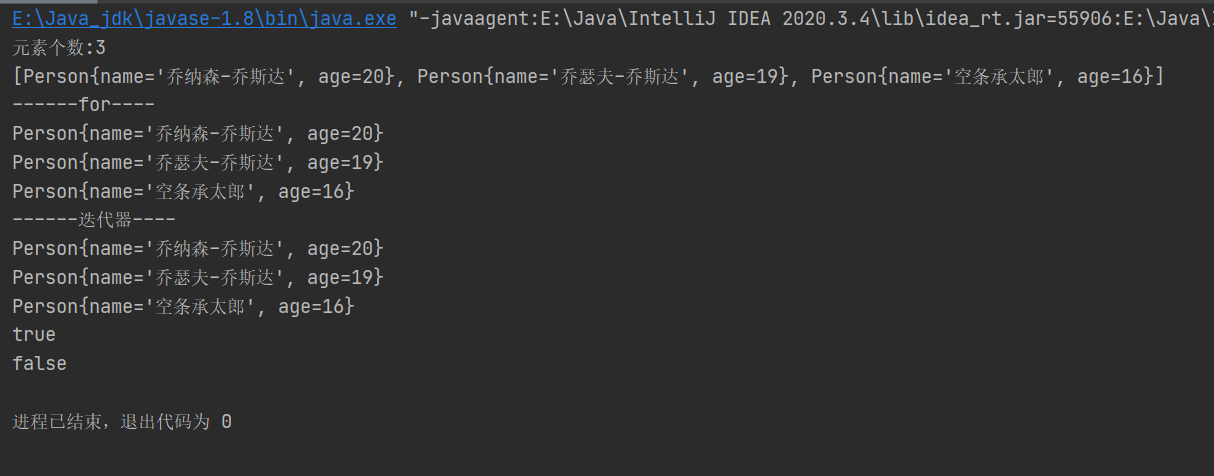
5.3.2、TreeSet
(1)简单使用
/**
* TreeSet的使用
* 存储结构:红黑树
*/
public class Demo4 {
public static void main(String[] args) {
//创建集合
TreeSet<String> treeSet = new TreeSet<>();
//1.添加元素
treeSet.add("xyz");
treeSet.add("abc");
treeSet.add("wer");
treeSet.add("opq");
System.out.println("元素个数:"+treeSet.size());
System.out.println(treeSet.toString());
//2.删除
treeSet.remove("wer");
System.out.println("删除后元素个数:"+treeSet.size());
//3.遍历
for (String str:treeSet) {
System.out.println(str);
}
//4.判断
System.out.println(treeSet.contains("opq"));
}
}
(2)保存Person类的数据
/**
* 使用TreeSet保存数据
* 存储结构:红黑树
* 要求:元素必须要实现Comparable接口,compareTo方法返回值为0,认为是重复元素
*/
public class Demo5 {
public static void main(String[] args) {
//创建集合
TreeSet<Person> persons = new TreeSet<>();
//1.添加元素
Person p1 = new Person("7乔纳森-乔斯达",20);
Person p2 = new Person("5乔瑟夫-乔斯达",19);
Person p3 = new Person("3东方仗助",16);
Person p4 = new Person("3东方仗助",17);
//直接添加不能添加进去,因为没有比较规则,即没有实现Comparable接口,需要在Person类中实现
persons.add(p1);
persons.add(p2);
persons.add(p3);
persons.add(p4);
System.out.println("元素个数:"+persons.size());
System.out.println(persons.toString());
//2.删除
persons.remove(p4);
System.out.println("元素个数:"+persons.size());
//3.遍历
Iterator<Person> iterator = persons.iterator();
while (iterator.hasNext()) {
System.out.println(iterator.next());
}
//4.判断
System.out.println(persons.contains(p1));
}
}
person类没有实现Comparable接口

person类实现Comparable接口
public class Person implements Comparable<Person>{
private String name;
private int age;
@Override
public String toString() {
return "Person{" +
"name='" + name + '\'' +
", age=" + age +
'}';
}
public String getName() {
return name;
}
public void setName(String name) {
this.name = name;
}
public int getAge() {
return age;
}
public void setAge(int age) {
this.age = age;
}
public Person() {
}
public Person(String name, int age) {
this.name = name;
this.age = age;
}
@Override
public int hashCode() {
int n1 = this.name.hashCode();
int n2 = this.age;
return n1+n2;
}
@Override
public boolean equals(Object o) {
if (this == o) return true;
if (o == null || getClass() != o.getClass()) return false;
if(o instanceof Person){
Person person = (Person) o;
if(this.name.equals(person.getName())&&this.age == person.getAge()){
return true;
}
}
return false;
}
//先按姓名比再按年龄比
@Override
public int compareTo(Person o) {
int n1 = this.getName().compareTo(o.getName());
int n2 = this.age - o.getAge();
return n1==0?n2:n1;
}
}
测试

Comparator接口实现定制比较(不需要元素实现Comparable接口)
/**
* 使用TreeSet保存数据
* 存储结构:红黑树
* Comparator:实现定制比较(比较器)
*/
public class Demo6 {
public static void main(String[] args) {
//创建集合,并指定比较规则(匿名内部类)
TreeSet<Person> persons = new TreeSet<>(new Comparator<Person>() {
@Override
//先比较年龄再比较姓名
public int compare(Person o1, Person o2) {
int n1 = o1.getAge() - o2.getAge();
int n2 = o1.getName().compareTo(o2.getName());
return n1==0?n2:n1;
}
});
//1.添加元素
Person p1 = new Person("7乔纳森-乔斯达",20);
Person p2 = new Person("5乔瑟夫-乔斯达",19);
Person p3 = new Person("3东方仗助",16);
Person p4 = new Person("4东方仗助",16);
persons.add(p1);
persons.add(p2);
persons.add(p3);
persons.add(p4);
System.out.println(persons.toString());
}
}
测试

TreeSet案例
/**
* 要求:使用TreeSet集合实现字符串按照长度进行排序
* Comparator实现定制比较
*
*/
public class Demo7 {
public static void main(String[] args) {
//创建集合并指定比较规则
TreeSet<String> treeSet = new TreeSet<>(new Comparator<String>() {
@Override
public int compare(String o1, String o2) {
int n1 = o1.length() - o2.length();
int n2 = o1.compareTo(o2);
return n1==0?n2:n1;
}
});
//添加数据
treeSet.add("hello");
treeSet.add("hello,world");
treeSet.add("dalian");
treeSet.add("kunkun");
treeSet.add("ikun");
treeSet.add("cat");
treeSet.add("beijing");
System.out.println(treeSet.toString());
}
}
测试

6、Map接口与实现类
Map体系集合

Map接口的特点:
用于存储任意键值对(Key-Value)
键:无序、无下标、不允许重复(唯一)
值:无序、无下标、允许重复
6.1、Map父接口与简单使用
Map父接口
特点:存储一对数据(Key-Value),无序、无下标,键不可重复,值可重复。
方法:
- V put(K key,V value) //将对象存入到集合中,关联键值。key重复则覆盖原值。
- Object get(Object key)//根据键获取对应的值。
- Set keySet() //返回所有key。
- Collectionvalues()//返回包含所有值的Collection集合。
- Set<Map.Entry<K,V>>//键值匹配的Set集合。
Map接口使用
/**
* Map接口的使用
* 特点:(1)存储键值对(2)键不能重复,值可以重复(3)无序
*/
public class Demo1 {
public static void main(String[] args) {
//创建Map集合
Map<String, String> map = new HashMap<>();
//1.添加元素
map.put("tom","汤姆");
map.put("jack","杰克");
map.put("rose","露丝");
//map.put("rose","ooo");value会被替换
System.out.println("元素个数:"+map.size());
System.out.println(map.toString());
//2.删除
// map.remove("tom");
// System.out.println("删除后元素个数:"+map.size());
//3.遍历
//3.1使用keySet()
System.out.println("-------keySet()遍历---------");
//Set<String> keySet = map.keySet();
for(String key:map.keySet()){
System.out.println(key+"---"+map.get(key));
}
//3.2使用entrySet()
System.out.println("-------entrySet()遍历---------");
//Set<Map.Entry<String, String>> entries = map.entrySet();
for (Map.Entry<String, String> entry: map.entrySet()) {
System.out.println(entry.getKey()+"---"+entry.getValue());
}
//4.判断
System.out.println(map.containsKey("jack"));
System.out.println(map.containsValue("杰克"));
}
}
测试
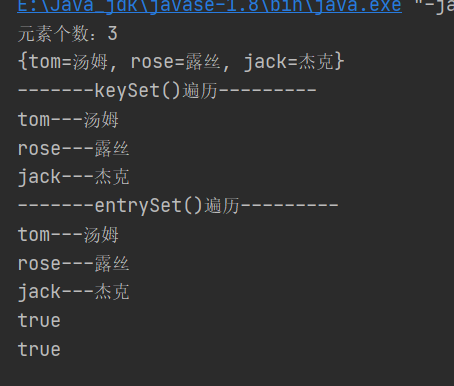
keySet()与entrySet()
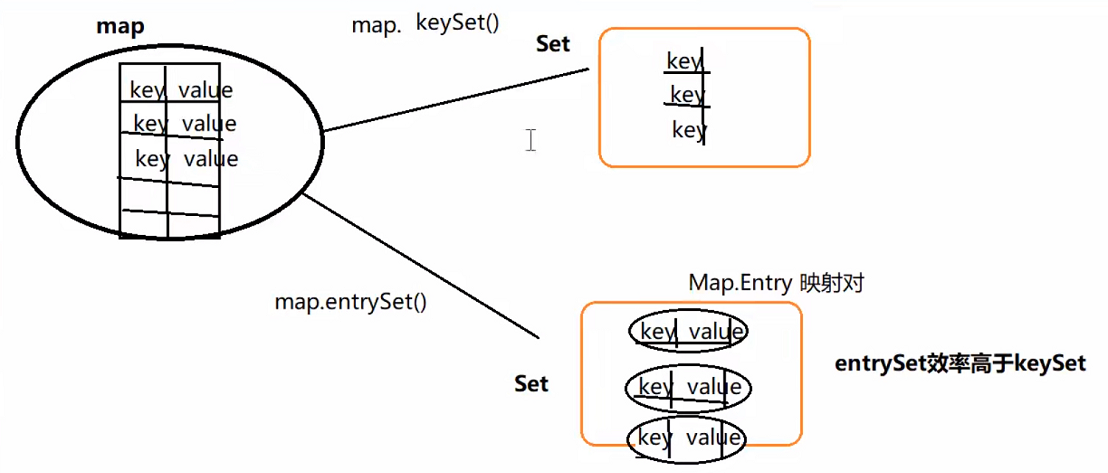
6.2、Map集合的实现类
HashMap【重点】
- jdk1.2版本,线程不安全,运行效率快
- 允许使用null作为key或value
Hashtable【了解】
- jdk1.0版本,线程安全,运行效率慢
- 不允许使用null作为key或value
Properties
- Hashtable的子类
- 要求key和value都是String
- 通常用于配置文件的读取
TreeMap
- 实现了SortedMap接口(是Map的子接口),可以对key自动排序
6.2.1、HashMap
Student类:
public class Student {
private String name;
private int stuNo;
public Student(String name, int stuNo) {
this.name = name;
this.stuNo = stuNo;
}
public Student() {
}
public String getName() {
return name;
}
public void setName(String name) {
this.name = name;
}
public int getStuNo() {
return stuNo;
}
public void setStuNo(int stuNo) {
this.stuNo = stuNo;
}
@Override
public String toString() {
return "Student{" +
"name='" + name + '\'' +
", stuNo=" + stuNo +
'}';
}
@Override
public boolean equals(Object o) {
if (this == o) return true;
if (o == null || getClass() != o.getClass()) return false;
Student student = (Student) o;
return stuNo == student.stuNo && Objects.equals(name, student.name);
}
@Override
public int hashCode() {
return Objects.hash(name, stuNo);
}
}
/**
* HashMap集合的使用
* 存储结构:哈希表(数组+链表+红黑树)
* 存储过程:
* (1)根据hashcode计算保存位置,如果位置为空,则直接保存,如果不为空,执行第二步
* (2)再执行equals方法,如果equals方法为true,则认为是重复,否则形成链表
*/
public class Demo2 {
public static void main(String[] args) {
//创建集合
HashMap<Student,String> students = new HashMap<>();
//1.添加元素
Student s1 = new Student("张三",503);
Student s2 = new Student("李四",509);
Student s3 = new Student("王五",505);
students.put(s1,"3班");
students.put(s2,"7班");
students.put(s3,"8班");
//students.put(s3,"9班");键重复不能添加进去,但是值会覆盖
students.put(new Student("张三",503),"3班");
//会添加进去,new会在堆中新创建一个对象,如果要让它添加不进去,要在Student中重写hashcode和equals方法
System.out.println("元素个数:"+students.size());
System.out.println(students.toString());
//2.删除
// students.remove(s1);
// System.out.println("删除之后:"+students.size());
//3.遍历
//keySet()
System.out.println("-------keySet()遍历---------");
for (Student key: students.keySet()) {
System.out.println(key.toString()+"========="+students.get(key));
}
System.out.println("-------entrySet()遍历---------");
for (Map.Entry<Student,String> entry: students.entrySet()) {
System.out.println(entry.getKey()+"========="+entry.getValue());
}
//4.判断
System.out.println(students.containsKey(s1));
}
}
测试

6.2.2、HashMap源码分析
static final int DEFAULT_INITIAL_CAPACITY = 1 << 4; // aka 16 HashMap初始容量大小
static final int MAXIMUM_CAPACITY = 1 << 30; // HashMap数组的最大容量
static final float DEFAULT_LOAD_FACTOR = 0.75f; //默认加载因子为0.75(到75%时扩容)
static final int TREEIFY_THRESHOLD = 8; //链表长度大于8时,调整成红黑树
static final int UNTREEIFY_THRESHOLD = 6; //链表长度小于6时,调整成链表
static final int MIN_TREEIFY_CAPACITY = 64; //链表长度大于8,并且集合元素个数大于等于64时,调整成红黑树
transient Node<K,V>[] table; //哈希表中的数组
transient int size; //元素个数
构造函数
public HashMap() {
this.loadFactor = DEFAULT_LOAD_FACTOR; // all other fields defaulted
}
//刚创建HashMap之后没有添加元素 table=null,size=0 目的是节省空间
put方法(这个源码不太容易理解,大家尝试理解前每个方法的前几行就可以,有能力的可以深入研究)
//put方法
public V put(K key, V value) {
return putVal(hash(key), key, value, false, true);
}
//putVal方法
final V putVal(int hash, K key, V value, boolean onlyIfAbsent,
boolean evict) {
Node<K,V>[] tab; Node<K,V> p; int n, i;
if ((tab = table) == null || (n = tab.length) == 0)
n = (tab = resize()).length;
if ((p = tab[i = (n - 1) & hash]) == null)
tab[i] = newNode(hash, key, value, null);
else {
Node<K,V> e; K k;
if (p.hash == hash &&
((k = p.key) == key || (key != null && key.equals(k))))
e = p;
else if (p instanceof TreeNode)
e = ((TreeNode<K,V>)p).putTreeVal(this, tab, hash, key, value);
else {
for (int binCount = 0; ; ++binCount) {
if ((e = p.next) == null) {
p.next = newNode(hash, key, value, null);
if (binCount >= TREEIFY_THRESHOLD - 1) // -1 for 1st
treeifyBin(tab, hash);
break;
}
if (e.hash == hash &&
((k = e.key) == key || (key != null && key.equals(k))))
break;
p = e;
}
}
if (e != null) { // existing mapping for key
V oldValue = e.value;
if (!onlyIfAbsent || oldValue == null)
e.value = value;
afterNodeAccess(e);
return oldValue;
}
}
++modCount;
if (++size > threshold)
resize();
afterNodeInsertion(evict);
return null;
}
// resize()方法
final Node<K,V>[] resize() {
Node<K,V>[] oldTab = table;
int oldCap = (oldTab == null) ? 0 : oldTab.length;
int oldThr = threshold;
int newCap, newThr = 0;
if (oldCap > 0) {
if (oldCap >= MAXIMUM_CAPACITY) {
threshold = Integer.MAX_VALUE;
return oldTab;
}
else if ((newCap = oldCap << 1) < MAXIMUM_CAPACITY &&
oldCap >= DEFAULT_INITIAL_CAPACITY)
newThr = oldThr << 1; // double threshold
}
else if (oldThr > 0) // initial capacity was placed in threshold
newCap = oldThr;
else { // zero initial threshold signifies using defaults
newCap = DEFAULT_INITIAL_CAPACITY;
newThr = (int)(DEFAULT_LOAD_FACTOR * DEFAULT_INITIAL_CAPACITY);
}
if (newThr == 0) {
float ft = (float)newCap * loadFactor;
newThr = (newCap < MAXIMUM_CAPACITY && ft < (float)MAXIMUM_CAPACITY ?
(int)ft : Integer.MAX_VALUE);
}
threshold = newThr;
@SuppressWarnings({"rawtypes","unchecked"})
Node<K,V>[] newTab = (Node<K,V>[])new Node[newCap];
table = newTab;
if (oldTab != null) {
for (int j = 0; j < oldCap; ++j) {
Node<K,V> e;
if ((e = oldTab[j]) != null) {
oldTab[j] = null;
if (e.next == null)
newTab[e.hash & (newCap - 1)] = e;
else if (e instanceof TreeNode)
((TreeNode<K,V>)e).split(this, newTab, j, oldCap);
else { // preserve order
Node<K,V> loHead = null, loTail = null;
Node<K,V> hiHead = null, hiTail = null;
Node<K,V> next;
do {
next = e.next;
if ((e.hash & oldCap) == 0) {
if (loTail == null)
loHead = e;
else
loTail.next = e;
loTail = e;
}
else {
if (hiTail == null)
hiHead = e;
else
hiTail.next = e;
hiTail = e;
}
} while ((e = next) != null);
if (loTail != null) {
loTail.next = null;
newTab[j] = loHead;
}
if (hiTail != null) {
hiTail.next = null;
newTab[j + oldCap] = hiHead;
}
}
}
}
}
return newTab;
}
HashMap源码简单总结
- HashMap刚创建时,table是null,为了节省空间,当添加第一个元素时,table容量调整为16
- 当元素个数大于阈值(16*0.75=12)时,会进行扩容,扩容后大小为原来的2倍,目的是减少调整元素的个数
- jdk1.8,当每个链表长度大于8,并且数组元素个数大于等于64时,会调整为红黑树,日的提高执行效率
- jdk1.8当链表长度小于6时,调整成链表
- jdk1.8以前,链表是头插入,jdk1.8以后是尾插入
7、Collections工具类
概念:集合工具类,定义了除存取以外的集合常用方法
方法:

代码实现
/**
* Collections工具类的使用
*
*/
public class Demo4 {
public static void main(String[] args) {
List<Integer> list = new ArrayList<>();
list.add(20);
list.add(77);
list.add(23);
list.add(89);
list.add(12);
//sort排序
System.out.println("排序前:"+list.toString());
Collections.sort(list);//升默认序
System.out.println("排序后:"+list.toString());
//binarySearch二分查找, 找到为下标,没找到为负数
int i = Collections.binarySearch(list, 12);
System.out.println(i);
//copy复制
List<Integer> dest = new ArrayList<>();
for (int j = 0; j < list.size(); j++) {
dest.add(0);
}
Collections.copy(dest,list);
System.out.println(dest.toString());
//reverse反转
Collections.reverse(list);
System.out.println("反转之后:"+list);
//shuffle 打乱
Collections.shuffle(list);
System.out.println("打乱之后:"+list);
//补充:list 转成数组
System.out.println("=======list 转成数组========");
Integer[] integers = list.toArray(new Integer[0]);
System.out.println(integers.length);
System.out.println(Arrays.toString(integers));
//数组转成集合
System.out.println("=======数组转成集合========");
String[] names = {"小明","小红","小王"};
//集合是一个受限集合,不能添加和删除
List<String> list1 = Arrays.asList(names);
System.out.println(list1);
//把基本类型数组转成集合时,需要修改为包装类
Integer[] nums = {100,200,300,400,500};
List<Integer> integerList = Arrays.asList(nums);
System.out.println(integerList);
}
}
测试
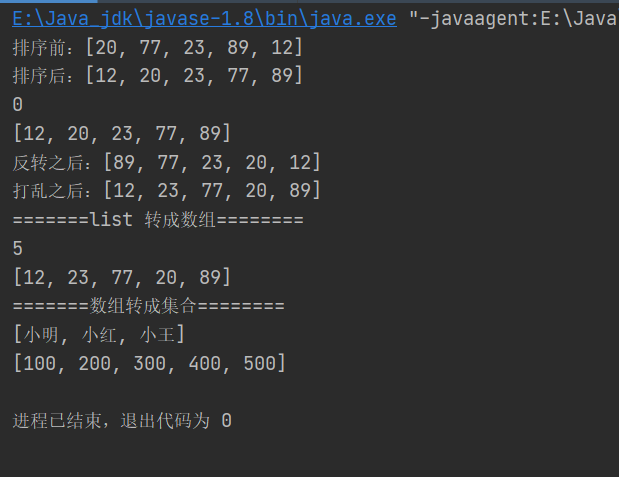
8、集合总结
最后,我们再看一下这张图回顾一下Java集合框架的重点和常用知识
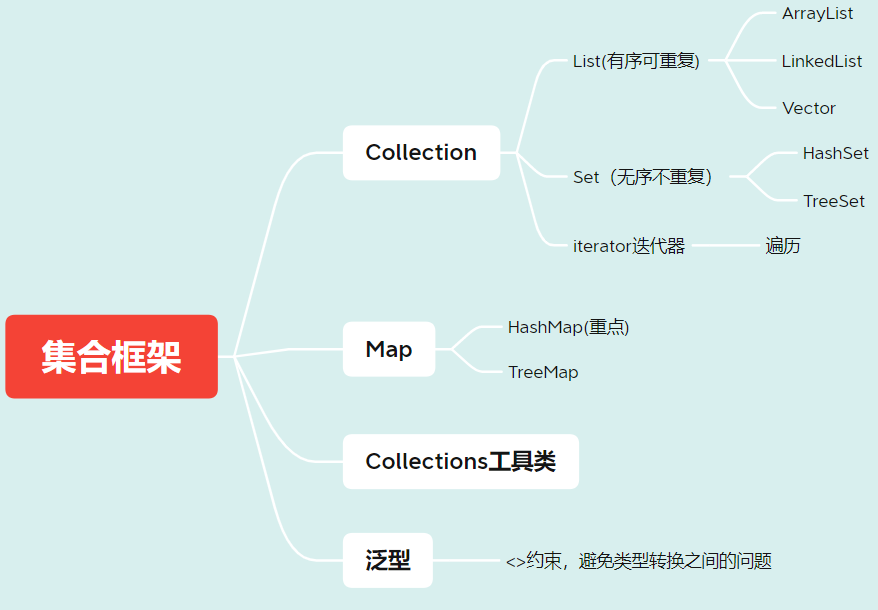
- 集合的概念:
- 对象的容器,和数组类似,定义了对多个对象进行操作的常用方法。
- List集合:
- 有序、有下标、元素可以重复。(ArrayList、LinkedList、Vector)
- Set集合:
- 无序、无下标、元素不可重复。(HashSet、TreeSet)
- Map集合:
- 存储一对数据,无序、无下标,键不可重复,值可重复。(HashMap、HashTable、TreeMap)
- Collections:
- 集合工具类,定义了除了存取以外的集合常用方法。
到这里关于Java集合框架的知识就结束啦°꒰๑'ꀾ'๑꒱°,希望大家都有所收获,觉得文章还可以的话可以点个推荐支持博主啊

最新文章
- 安装SQL Developer,连接Oracle 12c,创建新用户
- Underscore.js基础入门
- 异常检测算法--Isolation Forest
- 8大排序算法图文讲解 分类: Brush Mode 2014-08-18 11:49 78人阅读 评论(0) 收藏
- 《C++ Primer 4th》读书笔记 第9章-顺序容器
- C语言实验——一元二次方程Ⅱ
- SuperSocket入门(三)-Telnet多服务实例和服务实例交互配置详解
- 通用后台管理系统UI-AdminLTE:构造动态菜单栏
- 货币转换 I
- 部署WEB项目到服务器(四)部署WEB项目Forum到linux服务器(Ubuntu)详解
- Android学习之APP点击功能闪退问题的处理一
- linux 下端口close_wait 过多问题
- 2018.10.16 spoj Can you answer these queries V(线段树)
- Hadoop/Spark生态圈里的新气象
- WebX框架的页面授权
- linux的用户管理相关配置文件
- IDEA创建Maven项目和子模块
- 发现保存GIF格式后相素发生变化咋办
- 【P1274】魔术数字游戏(搜索+剪枝+模拟)
- @ApiModelProperty用法